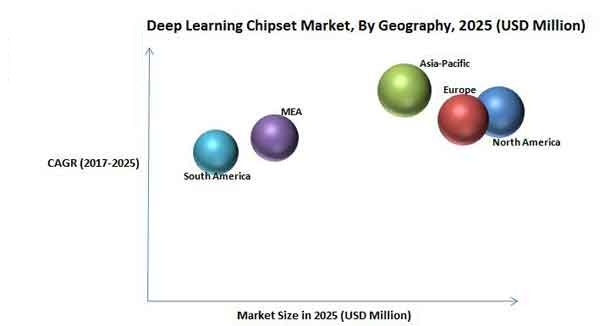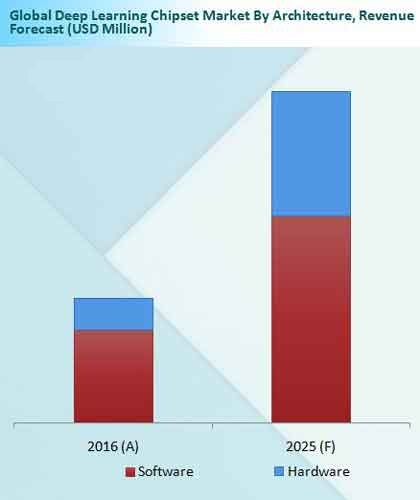Table of Contents
Report Description
The market for deep learning chipsets has been covered under the scope of this report. Deep learning is a part of the machine learning technology that enables computers to learn from past experience and allow them to understand and perform according to future requirements in terms of a hierarchy of concepts. In addition, deep learning technology is one of the integral parts of the value chain of the artificial intelligence process. The deep learning chipset market is expected to witness strong growth during the forecast period. The global deep learning chipset market has been segmented on the basis of:
- Chipset type
- Computing performance
- Architecture
- End user, and
- Region

It also provides a cross-sectional study of the global deep learning chipset market across broad regional segments such as North America, Europe, Asia-Pacific (APAC), Middle East and Africa (MEA), and South America under its scope. Across the globe, enormously increased digital data and improved algorithms for the purpose of reinforcement learning and deep supervised learning are expected to drive the market for deep learning chipsets in coming years. With the increasing adoption of IoT (internet of things) devices that promise to interlink billions of new devices through continuous data streaming, it is evident that much more digital data is actually going to disrupt the industry of machine learning and thus trigger the need for deep learning to find relevant insights from this huge volume of data. Currently, newly built algorithms are shifting the learning from one application to another, making it easier to learn from very few examples from other applications. Moreover, across the globe, various deep learning neural network providers are continuously investing in and adopting deep learning chipsets to enhance their innovative product portfolio and improve customer experience. All the above factors are subsequently expected to drive the demand for the deep learning chipset market worldwide.
Scope of the Report
A complete analysis of market dynamics, which includes the market drivers, restraints, and opportunities, is included within the scope of the report. Under the purview of the report, market dynamics for the different types of deep learning chipsets and distribution channels have been covered separately. Additionally, the country level trend for each region has also been covered under the scope of the report. Thus, this report provides an exhaustive study of the global deep learning chipset market and also provides a forecast of the market for the period from 2017 to 2025.
High-Level Analyses Covered in this Report
Under the scope of the report on global deep learning chipset market, several high-level analyses have been covered. This includes:
- The product-market trend analysis
- Product lifecycle analysis
- Porter’s five forces analysis, and
- Market attractiveness analysis
Key trends analysis discusses the current and upcoming trends in this market. Product life-cycle analysis analyses the current life-cycle stage of the product in the five wide geographic regions, such as whether the product is approaching maturity in a region or whether it is a new entrant, etc. Porter’s five forces analysis provides insights into the competitive scenario with regards to new entrants, substitutes, buyers, and suppliers. To provide a detailed insight into the global market, the market attractiveness analysis has been provided. The market attractiveness analysis details the investment attractiveness by chipset type, by computing performance, by architecture, by end user, and by geography.
Market Analysis
Deep learning technology is an integral part of machine learning technology that helps in the achievement and evolution of artificial intelligence. The architecture and working principals of the deep learning chipset are similar to those of neural networks that are inspired by our biological understanding of the brain. Till 2015, deep learning technology was primarily a software play, and the necessity for hardware fabrication was first determined in academia. However, only a few companies, including the major chipset manufacturers, have ventured into developing specialised chipsets until now.

Deep learning has enabled various practical applications of machine learning by overall extension of the field of artificial intelligence (AI). Driverless cars, better movie recommendations, face recognition, fraud detection, a better preventive healthcare system, determining security threats and curating a rich customer experience for its various customers are all covered within the working horizon of the deep learning chipset. Thus, the deep learning chipset is expected to augment various activities of the business in order to achieve overall success. Owing to its increasing adoption, the deep learning chipset market across the globe is anticipated to experience a robust growth rate throughout the forecast period, both in terms of revenue (USD Million) and volume (Million Units) from 2017 to 2025.
Deep Learning Chipset Market Dynamics
Deep learning chipsets are an integral part of the working principals of artificial intelligence. Therefore, there exists a direct relationship between the adoption rate of artificial intelligence across various industries and the market growth of deep learning chipsets. One of the most important factors expected to drive the demand for deep learning chipsets market at an exponential rate during the forecast period from 2017 to 2025 is the rapid adoption rate of artificial intelligence technology across various data-driven industrial sectors, including healthcare, manufacturing, automotive, agriculture, retail, security, marketing, and BFSI sectors, among others.

Moreover, rising demand for intelligent virtual assistance systems across various sectors, especially the BFSI and telecommunication sectors, in order to provide enhanced customer service is also predicted to create a promising market for deep learning chipsets in the coming years. Furthermore, increasing demand for computer vision applications across a wide range of applications, ranging from automatic inspection in the manufacturing sector to research and development activities, is also expected to drive the demand for deep learning chipsets during the forecast period from 2017 to 2025.
The Competitive Profiling
The competitive profiling of the key players in the global deep learning chipset market and their business segments has been exhaustively covered under the purview of the study. Moreover, key business strategies adopted by the leading players in the market have also been covered under the scope of the report.
Leading Companies in the Deep Learning Chipset Market
In 2016, only few companies have ventured into manufacturing deep learning chipsets. Some of the major players operating in the deep learning chipset include Intel (The U.S), NVIDIA (The U.S) and Qualcomm (The U.S) among others.
Report Highlights
- Impeccable insights related to relevant segment of the market.
- In depth research of key trends of the market.
- In-depth analysis of the competitive landscape
- Major push factors that will influence the growth of the market.
- Growth potential in different segments of the market till 2025.
- Key strategies executed by the market leaders to maintain growth in the market.
- Major restrictive factors of the market.
- Ways to generate new revenue.
Market Segmentation Overview
In order to discuss the deep learning chipset market from the viewpoint of both technology and market across different regions, including Asia-Pacific, North America, Europe, South America, the Middle East, and Africa, the market has been classified on the basis of chipset type, compute capacity, architecture, and end user.
Chipset Type
Based on chipset type, the deep learning chipset market is currently led by CPUs (central processing units) and GPUs (graphics processing units). However, the coming year is anticipated to witness an expanded role for other chipsets as well, including FPGAs (field programmable gate arrays), ASICs (application specific integrated circuits), and others.
- CPUs (central processing units)
- GPUs (graphics processing units)
- FPGAs (field programmable gate arrays)
- ASICs (application specific integrated circuits)
- Others
Computing Performance
In addition, depending upon the computing performance, the deep learning chipset market has been classified into low and high group. The low segment has a compute capacity of less than 1 TFlops and the high segment has a compute capacity of equal to or greater than 1 TFlops.
- Low compute capacity (<1 TFlops)
- High compute capacity (>=1 TFlops)
Architecture
On the other hand, depending on the component used in the fabrication process of the deep learning chipset, the market has been categorised into hardware and software sections. This report also covers the application of deep learning chipsets across various end-user segments, such as healthcare, sales and marketing, BFSI (banking, financial services, and insurance), security, and manufacturing.
- Hardware
- Software
End-user Segment
Among the different end-user segments, demand for deep learning chipsets from the security sector held the largest market share in 2016 and is expected to maintain its leading position throughout the forecast period. The rapidly changing cyber security ecosystem across the globe owing to rising demand for enhanced security solutions by various industries in order to encounter cyber threats and protect critical information from new types of cyber attacks is the primary factor attributed to this segment’s high market share. However, the BFSI sector is expected to create the most promising demand for deep learning chipsets in the coming eight years.
- Healthcare
- Sales And Marketing
- BFSI Sector
- Security
- Manufacturing
- Others
Deep Learning Chipset market: By Geography
- North America (U.S. and Canada)
- Europe (U.K., Germany, France, CIS + Scandinavia and Rest of Europe)
- Asia-Pacific (China, Japan, Taiwan, South Korea and Rest of Asia-Pacific)
- Middle East and Africa (Israel, South Africa and Rest of Middle East and Africa)
- South America (Brazil, Mexico and Rest of South America)
Regional Outlook
Geographically, North America generated the highest demand for deep learning chipsets in 2016, which is an outcome of the mushrooming startups across various parts of the U.S. that indulge in rapid research and development activities of artificial intelligence technology and provide various applications that are supported by AI. However, the wide concentration of semiconductor manufacturers in countries such as China, Japan, and Tokyo, along with the rapid adoption of AI in this region, is the most important factor expected to turn the Asia-Pacific region into the leading region both in terms of revenue and volume.



